How to use honeysuckle leaves: beneficial properties and contraindications
Honeysuckle is very popular in folk medicine. In addition to the berries, the leaves of the plant have excellent medicinal properties. They have a positive therapeutic and general strengthening effect on the human body. Read about the beneficial properties and contraindications of honeysuckle leaves in our article.
Why are honeysuckle leaves needed?
Due to its rich composition, the leaves of the plant have many beneficial properties that are used in medicine and cosmetology.
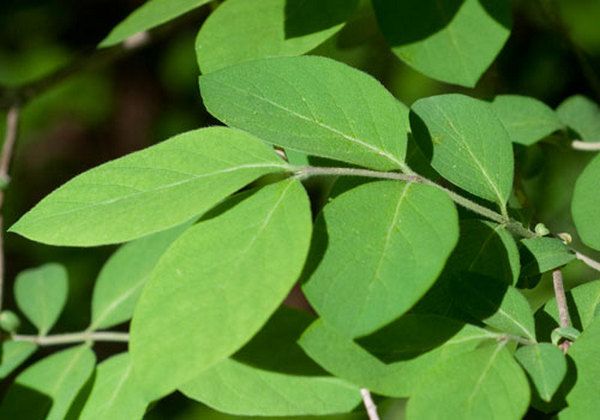
Chemical composition and properties
Honeysuckle leaves have almost the same chemical composition as the berries. The only difference is that the fruits contain simple sugars.
The raw materials contain a large amount of organic acids:
- sorrel;
- lemon;
- apple
You can feel a sour taste when chewing a fresh honeysuckle leaf. Due to the content of glycosides and tannins, a bitter taste will be felt.
The composition also contains:
- flavonoids;
- pectins;
- phytoncides.
These substances neutralize the effects of free radicals and help fight premature aging.
Microelements contained in the leaves enhance the antioxidant effect:
- magnesium;
- manganese;
- phosphorus;
- zinc;
- molybdenum;
- calcium;
- potassium;
- selenium.
Due to the content of carotene or fat-soluble vitamin A in the leaves, they are often used in the treatment of eye diseases.
Vitamin C content allows the plant to be used in the treatment of colds and respiratory diseases. The largest amount of ascorbic acid accumulates in honeysuckle bushes, which grow in the northern regions of Russia.
B vitamins provide significant support to the body, strengthen the immune system during illness, and normalize the functioning of the nervous and cardiovascular systems.
The amount of microelements and nutrients depends on the region where the shrub grows. The richest honeysuckle in nutrients can be found in the wild.
Reference. Selenium is one of the most powerful adaptogens, allowing the human body to withstand adverse conditions, external influences and diseases. It is very rarely found in plant materials.
Benefits and harms
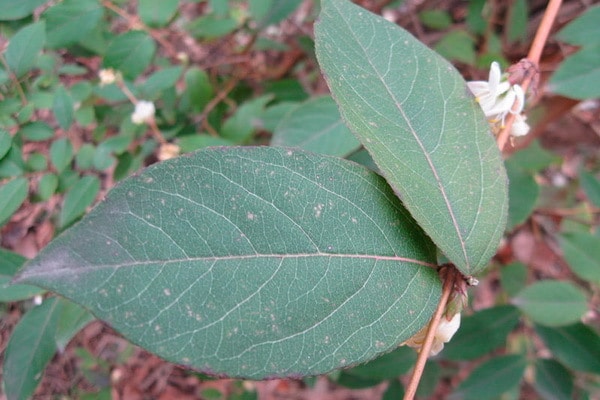
The plant has anti-inflammatory properties. Teas or decoctions prepared from the leaves suppress the spread of viruses, fungi and bacteria. Phytoncides help the body resist pathogens. With regular use of decoction or tea from honeysuckle leaves, you can quickly get rid of infection or overcome inflammatory processes in the body.
Bioflavonoids in the leaves improve the condition of the circulatory system and also help accelerate the regeneration of damaged tissues.
Medicinal properties:
- astringent;
- decongestant;
- antispasmodic;
- antimicrobial;
- antimycotic;
- diuretic;
- tonic.
The decoction helps solve the problem of indigestion.
Like any plant material, honeysuckle can cause allergies. Individual intolerance manifests itself in the form of hives, itching, and redness.
The high content of organic acids in the leaves causes active production of enzymes. People with high stomach acidity should not use decoctions and infusions from the leaves, so as not to aggravate these problems. In case of pancreatitis, the use of raw materials can be dangerous, since enzymes destroy the inflamed pancreas.
Honeysuckle is good for lowering blood pressure and eliminating headaches. However, in case of hypotension, taking decoctions from the leaves is contraindicated. It will increase nausea, dizziness and may cause fainting.
How to properly assemble and prepare
It is best to collect raw materials in dry weather in the morning or afternoon. The ideal time for harvesting is during the period when buds appear or just before the formation of berries. Young leaves, which contain the maximum concentration of nutrients, are best suited for this. They can be cut from branches using pruning shears, scissors, or simply torn off by hand. It is not recommended to wash the leaves after collecting.
Drying methods
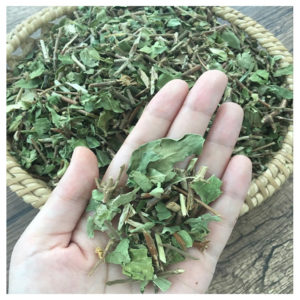
There are several drying options:
- Place the raw materials in a dark and dry place, stir periodically so that they dry well and do not begin to rot. This method will take from 10 to 14 days.
- Prepare tea. Knead the collected raw materials with your hands and leave in a dry and warm place for several hours. Grind the leaves using a meat grinder, mix well, dry in the oven on a baking sheet at 100°C, stirring occasionally. Ferment until the final evaporation of moisture from the raw material. Pour the finished tea into a glass storage container.
For faster drying, use an electric dryer.
Indications for use
Decoctions and teas from honeysuckle leaves are most often used in the treatment of:
- throat and eye diseases;
- swelling;
- gout;
- metabolic disorders;
- bladder diseases;
- diarrhea.
The plant has an antimicrobial effect, slows the progression of sclerosis, and stops bleeding.
Decoctions are very often used in the treatment of respiratory diseases in children and adults: tonsillitis, sinusitis, bronchitis.
Due to the high content of vitamins, the leaves act as a general tonic and help increase vital energy and overcome fatigue.
Infusions and decoctions have a diuretic effect and perfectly remove toxins from the body, and also reduce blood pressure.
Therapeutic effect
Let's consider the therapeutic effect on men, women, children.
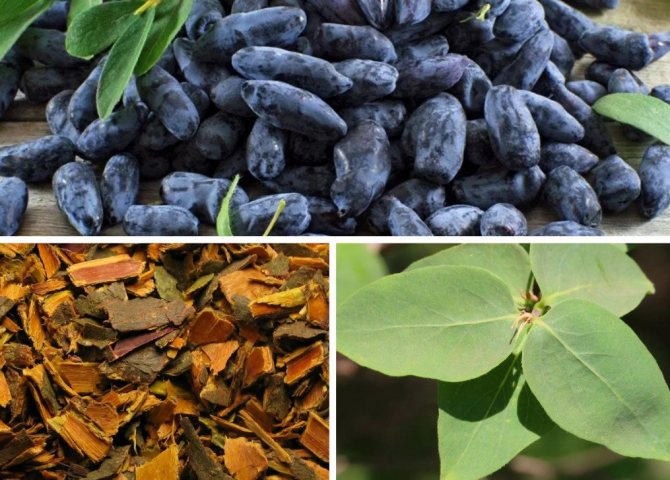
For men
The antibacterial properties of tea are widely used to treat benign prostatic hyperplasia and prostatitis. The use of honeysuckle tea helps reduce pain, reduce inflammation, and remove infection from the body.
Reference. The decoction has a positive effect on male libido, sexual activity and potency.
For women
Fermented tea is taken in the following cases:
- Heavy menstruation with severe pain.
- Menopause, dizziness, hot flashes and emotional surges.
- Any hormonal disorders.
For children
In the presence of diseases of the upper respiratory tract, a decoction of honeysuckle leaves is used only after medical treatment with antiviral drugs or antibiotics. The drink removes toxins from the body, thins mucus and facilitates its removal from the bronchi.
Honeysuckle leaves are used for the following respiratory pathologies:
- sore throat;
- bronchitis;
- sinusitis;
- tracheitis;
- bronchiolitis.
The leaves are used to prevent colds.To increase the body's resistance to infections and strengthen the immune system, tea is drunk in courses.
Reference. Children under 12 years of age are not recommended to use decoctions of honeysuckle leaves due to the content of glycosides in them. Use is possible only after consultation with a doctor.
How to cook
A decoction is prepared from pre-dried leaves:
- 5 g of leaves are poured into 300 ml of hot water.
- Bring to a boil and simmer for another 10 minutes over low heat.
- The finished broth is filtered, cooled, and honey is added if desired.
To prepare an infusion of leaves, you need:
- Pour 1 tsp. 200 ml hot water.
- Let it brew for half an hour.
- Take 4 times a day, 1 tbsp.
The infusion is effective for rinsing for diseases of the oral cavity.
After drying the leaves in the oven, use a ceramic teapot to brew tea:
- Take 1 tsp. raw materials per 300 ml of water.
- Let the tea brew for 20 minutes.
- Drink 2-3 times a day after meals, 1 tbsp.
Tea made from honeysuckle leaves is effective against intoxication of the body, and also as a general strengthening drink with a high content of vitamins and minerals.
This is interesting:
Is it possible to eat honeysuckle while losing weight and how is it useful?
How to use the product correctly
There are many options for using honeysuckle in folk medicine.
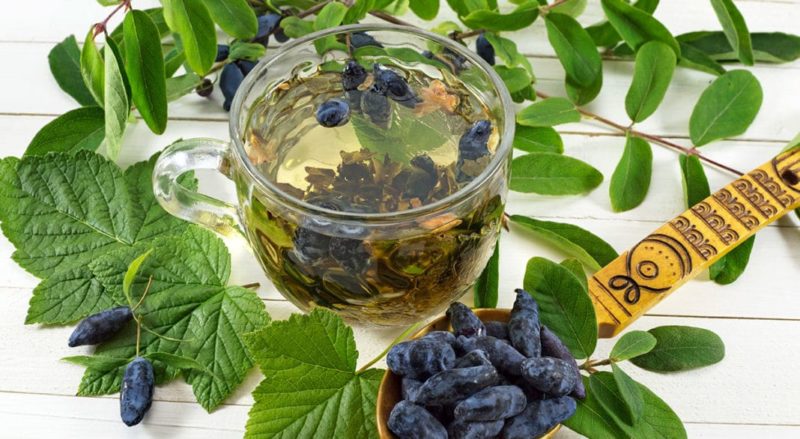
For eye diseases
A cotton pad or soft cloth is moistened in a warm, but not hot, broth and applied to the eyes for 10 minutes. The compress is effective for inflammation and conjunctivitis. The procedure is repeated 1-2 times a day.
For throat diseases
For sore throat and any throat diseases, a decoction of the leaves is used to gargle.The procedure is repeated 3 times a day after meals.
For rinsing hair
An infusion of honeysuckle and chamomile leaves in a 2:1 ratio is used to rinse the hair after washing. It adds shine to hair and has a slight lightening effect.
To prepare this infusion, chamomile and honeysuckle are poured with hot water and infused for 12 hours.
Contraindications
The leaves of the plant should be taken with caution if:
- diseases of the liver and pancreas;
- acute and chronic renal failure;
- hypotension.
The use of leaves is not recommended for pregnant or breastfeeding women.
Conclusion
Thanks to their rich chemical composition, honeysuckle leaves help in the treatment and prevention of numerous diseases. However, do not forget about contraindications. Before starting treatment, you should consult a specialist.